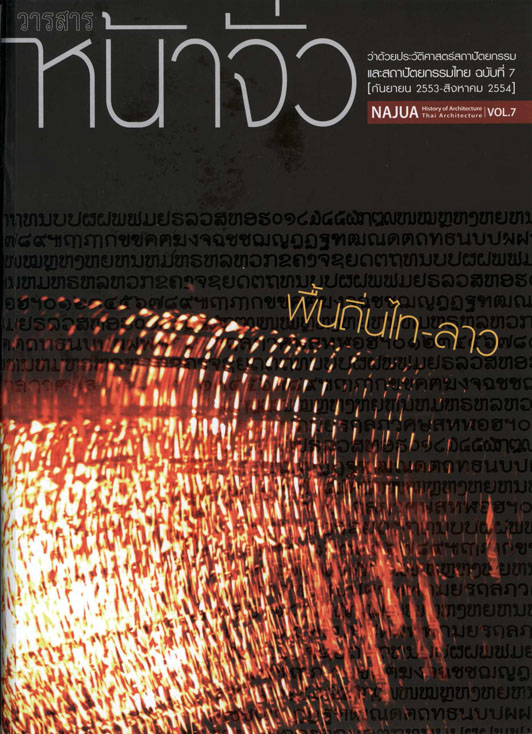การกลายรูปในเรือนลาวโซ่ง Transformation of Lao Song’s Houses
Main Article Content
Abstract
บทคัดย่อ
งานวิจัยนี้มีวัตถุประสงค์หลักในการค้นหาว่า ตลอดระยะเวลา 200 กว่าปีที่ลาวโซ่งตั้งถิ่นฐานบนแผ่นดินไทย ชนหมู่นี้มีการเปลี่ยนแปลงรูปลักษณ์เรือนอันเป็นที่อยู่อาศัยไปอย่างไรเมื่อใด และเพราะเหตุใด โดยใช้วิธีการวิจัยเอกสารร่วมกับการวิจัยสนาม ในแหล่งพื้นที่ศึกษาที่เป็นชุมชนของลาวโซ่ง ณ จังหวัดเพชรบุรี นครปฐม และสมุทรสาคร แล้วประเมินข้อมูลด้วยวิธีการวิเคราะห์รูปลักษณ์และการวิเคราะห์เชิงเปรียบเทียบ
ผลการวิจัยปรากฏว่า เมื่อแรกตั้งถิ่นฐานในไทยครั้งสมัยธนบุรีและต้นสมัยรัตนโกสินทร์ ลาวโซ่งปลูกเรือนทรงกระดองเต่า ตามแบบแผนดั้งเดิมเช่นเดียวกับในบ้านเกิดเมืองนอนที่สิบสองจุไท และเป็นเช่นนี้สืบเนื่องต่อมาอีกระยะเวลาหนึ่ง จนถึงราวทศวรรษ 2450 ลาวโซ่งจึงหันมารับเอาเรือนทรงไทยเข้าไปปลูกเป็นที่อยู่อาศัยของตน และเปลี่ยนมาปลูกเรือนทรงปั้นหยาและมนิลากันราวช่วงทศวรรษ 2500 ก่อนที่จะหันมานิยมปลูกเรือนทรงบังกะโลตั้งแต่ช่วงทศวรรษ 2520 เป็นต้นมา
การรับเอาเรือนทรงไทยเข้าไปปลูกสร้างเป็นที่อยู่อาศัยในหมู่ลาวโซ่ง เป็นกระบวนการปรับตัวเข้าสู่บริบทของวัฒนธรรมไทย แม้ภายหลังลาวโซ่งเปลี่ยนมาปลูกเรือนทรงปั้นหยาและมนิลาก็เป็นการปลูกเรือนคล้อยตามกระแสนิยมของสังคมไทยที่รับเอามาจากชาวตะวันตกอีกทอดหนึ่ง ทำนองเดียวกับความนิยมปลูกเรือนทรงบังกะโลที่ปรากฏขึ้นในระยะหลัง ทั้งหมดนี้แสดงให้เห็นการปรับตัวตามบริบทใหญ่เพื่อการดำรงอยู่อย่างกลมกลืนกับวัฒนธรรมคนหมู่มาก
Abstract
A present research attempts to find out the change of Lao Song’s houses over two hundred years-from early Rattanakosin Period till present time. Documentary sources including field-survey conducted in Lao Song communities in the province of Phetchaburi, Nakhon Pathom and Samut Sakhon, were methods used for collecting data. Then, all data were evaluated by means of morphological analysis and comparative analysis.
The results show that in the initial stages of settlement in Thailand, Lao Song built the same tortoise shape house as they did in their motherland. Until the decade 1900 they adopted traditional Thai house to build their dwelling. Fifty years later, the hip roof and hip-gable roof house became the favorite style. But nowadays, especially since the decade 1970, the majority of Lao Song’s houses had changed into the bungalow type.
A change in the style of dwellings in order to live suitable for the new context, Thai culture Lao Song built their houses in the style of Thai. All the same, when hip roof and hip-gable roof houses became a favorite style of Thai, there had also strong influenced on Lao Song culture as well as the bungalow house which flavored in the later years. All the above have expressed the adaptation of the subordinate minority to live suitable with the predominant majority.

